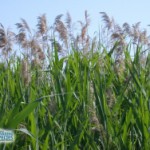On a trip home to Toronto this summer I noticed a number of signs on Hwy 400 warning of the Phragmites Invasion. I try to stay informed about issues that affect boaters but I had never heard of this invasive species before. Ontario has over 400 invasive plant species and this one never hit my radar. It has the potential to adversely affect recreational boating and boaters may be inadvertly helping the spread of Phrag. Theboating community needs to spread the word about Phragmites (frag-mite- teez) and do their part to help stop the invasion.
According to Invading species.com “Invasive Phragmites is an aggressive plant that spreads quickly and out-competes native species for water and nutrients. It releases toxins from its roots into the soil to hinder the growth of and kill surrounding plants. While it prefers areas of standing water, its roots can grow to extreme lengths, allowing it to survive in relatively dry areas.”
How does Phragmites Impact Boating in Canada?
This common reed grows aggressively along the waters edge killing off native plant species. It grows in a single mass an d left unchecked can form a barrier 15ft high. Agriculture and Agri-food Canada identified invasive Phragmites as the nation’s “worst” invasive plant. If this species spreads across Canadian wetlands it will adversely affect waterfront access and destroy fish habitat. Once it takes root it is very hard to eradicate so prevention is the best solution.
d left unchecked can form a barrier 15ft high. Agriculture and Agri-food Canada identified invasive Phragmites as the nation’s “worst” invasive plant. If this species spreads across Canadian wetlands it will adversely affect waterfront access and destroy fish habitat. Once it takes root it is very hard to eradicate so prevention is the best solution.
What Can you Do?
Boaters can help reduce the spread of aquatic invasive species by undertaking these easy clean boating practices:
- Remove all aquatic plants, mud and animals from your boat and equipment, including propeller, anchor, trailer and any other place they may be.
- Drain all the water from your boat, motor, bilge, live wells and bait wells.
- Dispose of any leftover bait in the trash, not in the water. Never release any bait, fish, animals or plants into a body of water unless they came out of that body of water.
- Rinse your boat and all fishing equipment with hot water (at least 104 degrees) OR thoroughly dry your boat and all fishing equipment and leave them in the sun for five days.
Learn More about Phragmites and do you part to help stop this invasive species.
www.stoptheinvasion.ca
greatlakesphragmites.net

